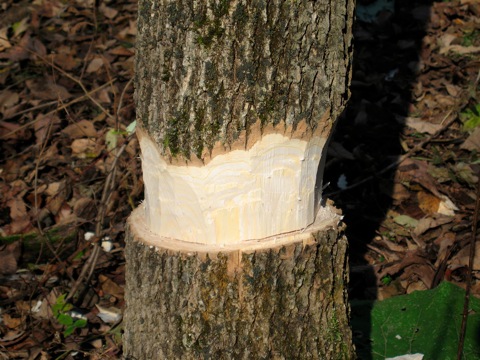A million different things can kill a tree: pests, drought, improper sight selection, floods – the list is endless. But the most maddening ways by which trees die are those that could have been easily avoided. Take for example, girdling – a process by which a tree’s phloem and cambium are damaged, by wounds occurring around a trunk’s circumference.
An (Often) Lethal Practice
Few girdled trees survive for very long. In fact, girdling is such a lethal threat to trees that foresters often use a version of the technique when trying to deliberately kill trees without the use of herbicides. In this case, the forester would cut a several-inch-wide band around a tree’s trunk, being sure to penetrate all the way down to the wood. Ironically, some fruit-tree farmers deliberately girdle their trees to improve fruit production, but in such cases, the wounds created are small enough for the tree to repair.
However, trees are more commonly girdled when someone deliberately wraps an item around a tree, but fails to remove it in short order. As the tree grows, the offending item becomes tighter and tighter, eventually slicing through the tree’s bark.
Damaged Tree Anatomy
Most trees can sustain a little bark damage; part of the bark’s evolutionary purpose, after all, is to shield the tree’s more delicate interior. But if the problem is not rectified at this stage, the damage will only get worse. Soon after penetrating the tree’s outer bark, the rope, wire or fabric strangling the tree will begin to damage two important cell layers: the phloem and the cambium. If a significant portion of either cell layer is destroyed, the tree is likely to die.
A tree’s phloem serves as a two-way transport system, that allows trees to move sugars up and down a branch or trunk, as needed. The phloem is present in the form of a thin band that stretches around the circumference of each branch or trunk. Accordingly, minor wounds are easily tolerated, but wounds that affect about one-third or more of the trunk effectively starve a significant portion of the root system, dooming the tree to a premature death.
Like the phloem, a tree’s cambium also occurs as a band of tissue, but it is located immediately inside the ring of phloem. Cambium is a type of tissue known as a meristem, which means that it is an area of rapid cell division – essentially growth. As the cambium divides, it produces both the xylem (wood) tissue to the inside and the phloem tissue to the outside. Obviously, the cambium is an important tissue for the tree, so it is imperative that it, like the phloem, remain undamaged.
Other Causes of Girdling
Some of the other ways in which trees become girdled include beavers and other rodents, or vandals, who carve their names into a living tree’s wood. However, trees can actually girdle themselves, by producing roots that encircle the trunk, eventually cutting off the movement of resources through the phloem.
If you require any assistance from your local tree surgeon, contact Arbor Tree Surgeons today!
The post Protect Your Trees From Girdling appeared first on Arbor Tree Surgeons.
Do you want to Find local tree Surgeon in London who can help you to maintain the tree at your place? If yes then visit Vetted trades online. We have the best tree surgeons who are well skilled and professional.
ReplyDelete